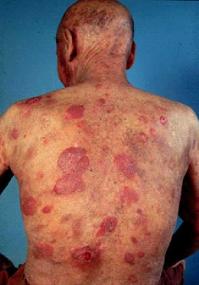Mycosis Fungoides
Home > Clinical Concepts In Radiation Oncology > Anatomy, Physiology > Miscellaneous > Mycosis Fungoides
Can we please get your advice on this one question?
Mycosis fungoides is the most common of the cutaneous T-cell lymphomas, a group of rare cancers that develop in the skin. Sezary syndrome, a more rare form, occurs in about 5% of all cases of mycosis fungoides. In the United States, just about 1000 new cases of mycosis fungoides occur per year. It affects men twice as often as women, and is more common in black people than in whites. Mycosis fungoides can begin at any age, but the most common age is 50 years old. The cause of the disease is unknown.
SymptomsMycosis fungoides progresses in stages, which are defined by the skin symptoms:
Patch phase - The skin has flat, red patches; in dark-skinned individuals these may appear as either very light or very dark patches. They are very itchy.
Some areas may be raised and hard (plaques). The patches and plaques often appear on the buttocks, groin, hips, under the arms, and on the breasts/chest.
Skin tumors phase - Red-violet raised lumps (nodules) appear and may be dome-shaped (like a mushroom) or be ulcerated.
Skin redness (erythroderma) stage - In addition to the patches and tumors, the individual's skin developed large red areas that are very itchy and scaly. Skin folds in the face may thicken, and skin of the palms and soles may thicken and crack.
Lymph node stage - In this stage, mycosis fungoides begins to move to other parts of the body. The first parts affected are the lymph nodes, which become inflamed, and often cancerous. Cancer may spread to the liver, lungs, or bone marrow.

Picture shows the signs & appearance of mycosis fungoids.
Diagnosis Typically there is about 6 years from the time symptoms begin to the diagnosis of mycosis fungoides. Confusion with other conditions is common. A sample of the skin can be taken (skin biopsy) and examined for the disease. Other laboratory tests can be done to determine the progression of the cancer.
Treatment If mycosis fungoides is in the early stage, treatments such as steroid creams, chemotherapy applied to the skin, or electron beam radiation may be used. The goal is to put the cancer in remission, which often lasts a long time. If an individual's disease does not respond to the skin treatments, or the disease has progressed to the tumour stage, systemic treatments such as recombinant alfa interferon or chemotherapy may be used. There is no cure for mycosis fungoides, so how long a person survives with the disease depends on how far it has spread by the time it is diagnosed and treatment begins.
Questions:
1. What will be the treatment modality for mycosis fungoides?
a) Chemotherapy
b) Radiation therapy
c) Steroid creams
d) All
Answer:
d) All
References:
1. http://www.emedicine.com/med/topic1541.htm
2. http://rarediseases.about.com
3. http://www.cancer.gov
Home > Clinical Concepts In Radiation Oncology > Anatomy, Physiology > Miscellaneous > Mycosis Fungoides
FREE Infographic What successful people believe. What successful people do
Dictionary of Cancer Terms
Need help understanding a word? Here is an electronic resource that gives meaning to Cancer terms and their usage.

StrengthsFinder 2.0